I added British units in Syria and Iraq, based on garrison requirements, as well as specious Soviet troops around Tibilsi. Grabbed the latter from Winter War. Always like to PUB (Pretty Up The Battlefield).
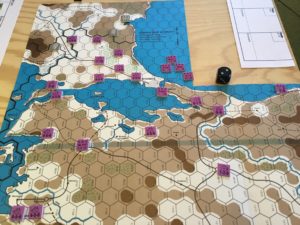
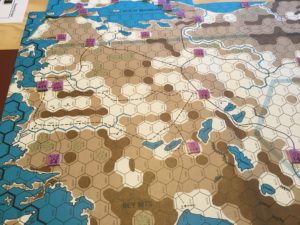
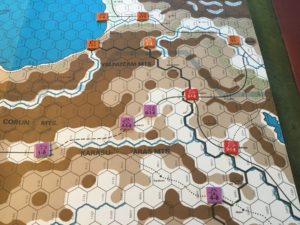
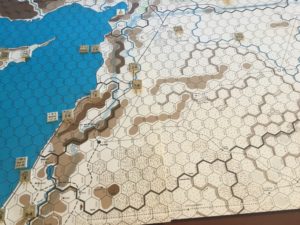
I added British units in Syria and Iraq, based on garrison requirements, as well as specious Soviet troops around Tibilsi. Grabbed the latter from Winter War. Always like to PUB (Pretty Up The Battlefield).




Have everything set up and ready to go. The Neutral Order of Battle calls for Turkey to receive foreign aid in the form of replacement points for upgrading units. The Allies historically provided aid to Turkey.
I’ll use the acceptance of this Allied aid as another pretext for invasion, but will only complete one-half the 1942 upgrades.
The overall effects convert infantry divisions from supported to non-supported, upgrades the 6-4-8 light armored division to a 7-10 armored division, and adds 1 ARP, as well as Hurricanes and P-40s to the Turkish air arsenal.
Added corps troops, with Army command retaining control of some assets, including the parachute division. The Italians provide a weak “division” to be used for rear area security (RAS). The weak German 52nd Corps, really a reinforced division, will perform RAS and airfield construction duties.
Due to the demands of other theaters, Fliegerkorps I contains a mix of older Luftwaffe assets. The antiaircraft units’ primary mission is airfield security. Aircraft mix and density is also driven by a weak air opponent and the need for maximum tactical air support.
One picture is supposedly worth a thousand words.
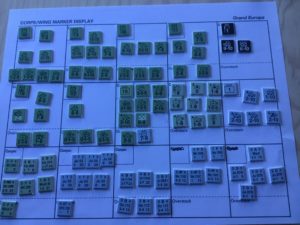
World At War Issue #49 provides the basics task organization for German forces deployed in either Bulgaria or Greece. War In The Desert (WITD) contains Turkish units and their initial dispositions.
However, what about allies?
At first, I assumed Germany would call on its Bulgarian allies for significant assistance. In addition, it’s possible that revanchist Greek and pro-fascist Yugoslavian units (Chetniks) might be formed. While the latter would be of little value in the initial attacks, they could provide rear area/security forces.
On second thought, I decided not to use these forces. Supposedly there was a good deal of pro-German sentiment in Turkey due to their close relations before and during World War I. To invade with long standing enemies would eliminate the possibility of any support from the nationalist Turks, much less put them in a security role policing Turkish cities. However, Bulgarian and Greek troops might be useful if massed at the border to tie down Turkish forces.
The Germans would be on their own, with limited ground and air assistance from the Italians, ever eager for a piece of any territorial or resource pie, but already stretched thin in North Africa.
I still have to figure out what assistance the Turks might receive from either the United States and/or Great Britain. I am assuming that the Soviet Union will be too hard pressed by the Wermacht’s summer offensives and need to hold their portion of the Iranian oil fields to provide any help to the Turks.
The next post will cover the Axis forces in detail, plus a thrilling photo of initial Turkish dispositions.
Huge Disclaimer Primarily For Those That Were And Have Probably Been Involved In Flame Wars In Any Form Of Europa List Past, Present And Future……
This is not an attempt at crafting an A Strange Alternate History Scenario……..Just playing with counters and possibilities.
Every time War In The Desert (WITD) comes off the shelf, I’ve looked at all those Turkish counters, and what a waste it is they remain neutral and unplayed.
Information concerning “Gertrude”, the German plan to invade Turkey, seems scarce and vague. Strategy and Tactics published a World At War game a couple of years ago. I bought it, looked it over, and sold it. Too much emphasis on special operations, which seemed strange for an operational game. However, I did note their conjectural divisional/corps Axis force list as a starting point for Europa, as Turkish initial dispositions and reinforcements are in WITD.
Gertrude was considered an unnecessary diversion of resources, given the demands of other theaters. Maybe the operation would have taken place if Hitler pursued a Southern Strategy.
Developing a context for invasion became an interesting thought exercise. Plausibility of each of these factors is, by definition, subject to plenty of debate and/or outright dismissal. However, I had to start somewhere.
During the process, I came to more fully appreciate how strategically important Great Britain’s operations during the Spring and Summer of 1941 were. During this period, Britain quashed the Golden Square’s revolt in Iraq, invaded Syria to remove the collaborationist Vichy forces and, with the Soviet Union, invaded and occupied pro-German Iran. These actions secured Turkey’s southern borders from possible pro-German military activities.
My framework assumes these operations take place, despite the interesting possibilities inherant in an invasion of Turkey involving Vichy, Iraqi and, possibly, Iranian troops.
The framework also assumes an invasion would not have taken place in 1941 after Marita-Merkur or before Operation Barbarossa.
This leaves Spring-Summer of 1942 as a possible time frame for invasion. However, German forces were stretched to the limit for Case Blue, with other assets committed to Rommel in North Africa.
To get around these limiting elements, my framework assumes the Germans pulled back from Moscow in late 1941, avoiding significant losses during the Soviet winter counter-offensive, with greater resources available in the East for 1942’s offensives. Also, that units in France were available for use in Gertrude. Operation Jubilee (Dieppe) did not occur until August.
Fall Gertrude would now be a pincer aimed at meeting Case Blue’s forces in the vicinity of Grozny, securing Turkish mineral resources and the Baku oil fields. The victorious German forces would now threaten British held Syria and, by extension, the Suez Canal.
It’s a start. Accepting these highly arguable assumptions, the next step was to develop a German force list.
The bad news came on Thursday. Tim couldn’t make it to our annual Labor Day Weekend wargaming/college football blow-out. His pup, Crater, was not doing well and putting her in a kennel was out of the question.
Had just finished setting up the maps and sorting the counters for Storm Over Scandanavia’s Campaign for Sweden Scenario. Might as well make the best of it.
This is a hypothetical German attack after the Fall of Fance. The timeframe is July-September 1940.
An infantry affair, with very limited armored resources for both sides. The Germans do have air superiority and a wealth of General Support air assets. This advantage is mitigated by wooded/lake terrain. To make things even more challenging, much of the German commander’s combat power is in the extreme north of Norway, and will have to work its way south, or be railed to a more central position.
The Swedish set-up is mandated by their mobilization region (MR). There are also garrisons in each region. They are immediately activated once Germans enter the area, or activiated during the initial phase if the Germans are adjacent to the region.
All victory point calculations aside, the Germans must take Stockholm. The Swedish deployment has made an amphibious attack (using rail ferries!), implausible. As mentioned, a northern axis of advance will take too much time. So the main effort, using three corps, will be through west-central Sweden with axes of advance channelized by lakes and terrain.
Should be interesting. Here’s a quick photo of the setup.
Real pleasant couple of days in Portland. Hotter than Hell, but we stayed refreshed and hydrated.
Maybe that’s one reason not a lot of gaming took place. Also a perceived need to view a few action films outweighed the desire to push cardboard.
We played “Operation Exporter” from War In The Desert. This is an operational simulation of the Allied invasion of Syria. Not exactly Tim’s cup of tea – low counter density, only a small portion of the map used and….gasp…..no real tanks (only a couple of Vichy light tank units with attack strengths of 1). The Allies will win, it’s just a matter of time. However, the victory point schedule makes time of the essence
Nonetheless, Tim did a great job as Allied Commander. He used his one motorized asset to harass the Vichy flanks and optimized the use of his limited air assets and naval gunfire. He also quickly assembled the two divisions available to him, with their enhanced combat power and zones of control. The regiments and brigades that make up all the Vichy forces cannot be formed into divisions.
I played my part by having a (typical) cavalier approach to victory conditions. While Tim didn’t win on VIPS, he certainly won the game.
I didn’t fare as well when we switched sides.
This is a good little scenario. It’s viewed as excellent starter game as it has all of the Europa food groups, but without the counter density to make the experience overwhelming.
He’ll be out at The Pinecone Lodge around Labor Day for Storm Over Scandanavia’s hypothetical scenarios involving the invasion of Sweden.
Opened up a box and it jumped right out at me! “It” is an old S&T magaizine game, Saipan.
Why not? It’s solitaire and is the first game I’ve ever played that has any of my old units in it (2/24 and HQ 24th Marines).
It’s another slog. Wristage and more wristage; have to reduce 88 (yes 88!), Japanese fortifications, plus the chance of encountering Japanese troops every hex you move into (except destroyed fortifications). Lots of rolling to do. I can handle that, but what’s vexing is the step losses. Yes, one has to use numbered chits to designate losses. Ugh.
All that griping aside, the system seems viable, with NGF, Air support, Japanese coastal defenses, and reasonable command and control (called Lines Of Communication) rules for Division and Regimental HQs. All in all, the game seems a reasonable representation of a meat grinder of a campaign.
I have Bloody Buna on the table and now this damn thing. It is a rut! Need to get an East Front game out (and not Stalingrad) next!
Mangled Turn 1, forgetting Japanese reactions to Marine movement. But, it was an easy re-set. Will try it again tonight.
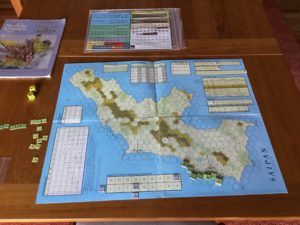
Undertook a mini project when TAD. It was TAC – Table Air Combat.
This is a simple, fun, inexpensive WWII aerial combat game with a wide variety of aircraft types. It can be found over at Wargamevault.
You get a PDF copy of the rules with each aircraft type. The PDF is very well done. Other help is available for free download.
The aircraft maneuvering card includes all the information you need to fly the aircraft, so after a few plays, and familiar with the general rules, you can seamlessly transition to any aircraft you like.
The counters show a single aircraft on one side, and two aircraft on the other I’m thinking about mounting 1/700 aircraft on a counter for a 3-D effect.
Speaking of 3-D, the system incorporates “energy” as a means of simulating vertical maneuver. The concept is simple, an aircraft can gain energy by climbing (reducing linear movement), which allows it to gain speed in a dive.
The footprint is very small, making it a great travel game.
For what it is…..it’s great!
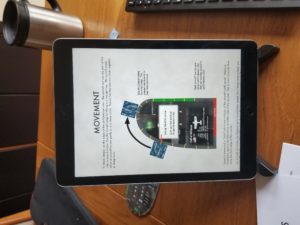
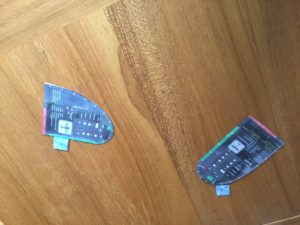
Was able to get through about 12 turns of Bloody Buna before I left for latest elder-care iteration.
It’s easy to understand why the response to this game was muted. Supply is everything, and there isn’t enough of it. Unlike many games where new supply counters are generated every turn, or MSRs linking supply sources to units are lengthy and developed, this game has short MSRs (2-4 hexes), and a very limited number of supply counters.
The result is the need to accept attrition die rolls as the cost of conducting business. While Allied units can huddle in defensive positions near supply sources, they will have to conduct operations far from these sources in order to win. The Japanese face a dwindling level of supply as the campaign progresses, and will have to hold on to their gains in order to eke out at least a marginal victory.
This isn’t the Western Desert. No booming and zooming.
So far, the Japanese were able to advance to Kokoda, eliminating Australian units that were tasked with a delay/defend mission. However, the Japanese are now on half-supply.
Another Japanese force moved east of Buna to cut off Allied forces that had moved west from Milne Bay. Again, both sides will soon be out of supply and subject to random attrition and accompanying loss of combat power.
I’m charmed by this game, if only because of the limitations created by factors taken for granted in so many other games.
Here’s a couple of bad pics depicting the Japanese attack on Kokoda, and the situation when I left. Number chits indicate supply turns remaining.